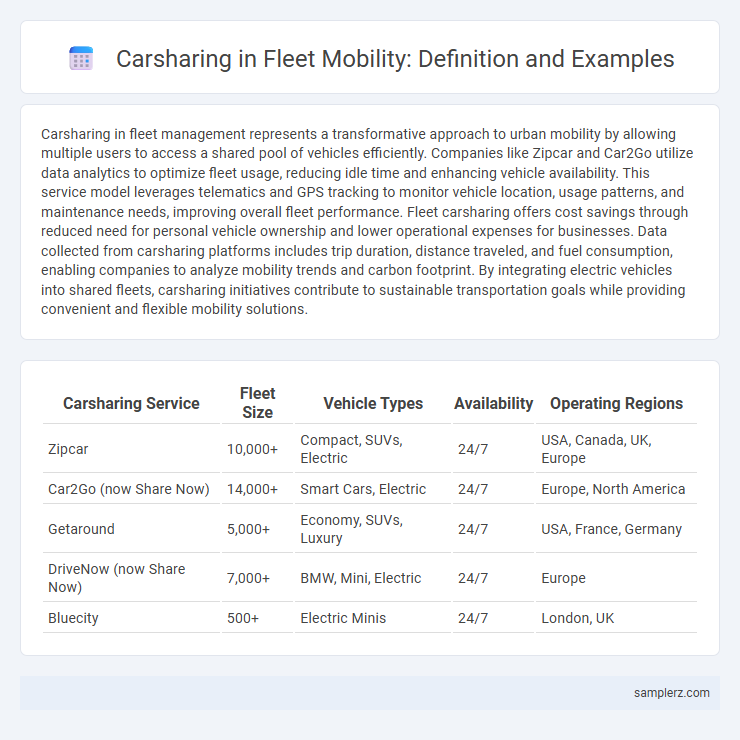Carsharing in fleet management represents a transformative approach to urban mobility by allowing multiple users to access a shared pool of vehicles efficiently. Companies like Zipcar and Car2Go utilize data analytics to optimize fleet usage, reducing idle time and enhancing vehicle availability. This service model leverages telematics and GPS tracking to monitor vehicle location, usage patterns, and maintenance needs, improving overall fleet performance. Fleet carsharing offers cost savings through reduced need for personal vehicle ownership and lower operational expenses for businesses. Data collected from carsharing platforms includes trip duration, distance traveled, and fuel consumption, enabling companies to analyze mobility trends and carbon footprint. By integrating electric vehicles into shared fleets, carsharing initiatives contribute to sustainable transportation goals while providing convenient and flexible mobility solutions.
Table of Comparison
| Carsharing Service | Fleet Size | Vehicle Types | Availability | Operating Regions |
|---|---|---|---|---|
| Zipcar | 10,000+ | Compact, SUVs, Electric | 24/7 | USA, Canada, UK, Europe |
| Car2Go (now Share Now) | 14,000+ | Smart Cars, Electric | 24/7 | Europe, North America |
| Getaround | 5,000+ | Economy, SUVs, Luxury | 24/7 | USA, France, Germany |
| DriveNow (now Share Now) | 7,000+ | BMW, Mini, Electric | 24/7 | Europe |
| Bluecity | 500+ | Electric Minis | 24/7 | London, UK |
Overview of Carsharing in Fleet Mobility
Carsharing in fleet mobility enhances operational efficiency by enabling multiple users to access shared vehicles on-demand, reducing the total number of cars needed and lowering overhead costs. Companies adopting carsharing systems report a significant decrease in fleet size while maintaining high availability and flexibility for employees. Integration with digital platforms allows seamless booking, real-time tracking, and better utilization rates, making carsharing a sustainable mobility solution for modern fleets.
Leading Carsharing Companies for Fleets
Leading carsharing companies for fleets such as Zipcar for Business, Enterprise CarShare, and Getaround for Work provide scalable solutions to optimize corporate vehicle management. These platforms offer real-time vehicle tracking, flexible booking systems, and efficient cost control, enhancing fleet utilization and reducing operational expenses. Integration with telematics and mobile apps supports seamless user access and data-driven decision-making for mobility managers.
Corporate Fleet Carsharing Models
Corporate fleet carsharing models optimize vehicle utilization by allowing employees to access shared company cars on-demand through digital platforms, reducing the need for individual car ownership. These models integrate real-time tracking and reservation systems to enhance fleet management efficiency and lower operational costs. Companies adopting fleet carsharing often report decreased parking demand and significant reductions in overall fleet size and carbon emissions.
Benefits of Carsharing for Fleet Operators
Carsharing in fleet management significantly reduces operational costs by minimizing vehicle acquisition and maintenance expenses. Fleet operators benefit from improved asset utilization and greater flexibility in vehicle allocation, enabling efficient response to fluctuating demand. Enhanced sustainability through reduced emissions and fuel consumption supports corporate responsibility goals while optimizing resource management.
Case Studies: Carsharing Integration in Fleets
Case studies on carsharing integration in fleets highlight significant improvements in operational efficiency and cost reduction. Companies like Zipcar and Enterprise have demonstrated successful implementation by optimizing vehicle utilization and reducing fleet size while maintaining service availability. Data shows fleets with integrated carsharing systems experience up to 30% lower maintenance costs and increased employee satisfaction due to flexible access to vehicles.
Technological Solutions for Fleet Carsharing
Advanced telematics systems enable real-time vehicle tracking and predictive maintenance, optimizing fleet availability and reducing downtime in carsharing services. Integration of IoT sensors facilitates efficient energy management and usage analytics, improving operational efficiency and user experience. Mobile apps with AI-powered booking and keyless entry features streamline access, enhancing convenience and supporting seamless fleet management.
Environmental Impact of Carsharing Fleets
Carsharing fleets significantly reduce greenhouse gas emissions by lowering the total number of vehicles on the road and promoting the use of fuel-efficient or electric cars. Studies show that carsharing users drive 30% fewer miles annually, contributing to decreased air pollution and reduced urban congestion. Implementing electric vehicle (EV) carsharing models further amplifies environmental benefits by minimizing reliance on fossil fuels within urban mobility systems.
Challenges in Fleet Carsharing Implementation
Fleet carsharing implementation faces challenges such as dynamic vehicle allocation, high maintenance costs, and integration with existing transportation infrastructure. Ensuring real-time tracking and efficient routing requires advanced telematics and data analytics to optimize fleet utilization. Addressing regulatory compliance and user behavior management is crucial to sustaining operational efficiency and customer satisfaction.
Future Trends in Carsharing Fleet Mobility
Emerging trends in carsharing fleet mobility emphasize electrification, autonomous driving, and AI-powered fleet management systems that enhance efficiency and reduce environmental impact. Integration of shared electric vehicles (EVs) with smart city infrastructure enables seamless, sustainable urban transport solutions. Advanced data analytics optimize vehicle distribution and maintenance schedules, driving future scalability in carsharing services.
Best Practices for Managing Carsharing Fleets
Implementing real-time vehicle tracking and usage analytics enhances fleet efficiency by minimizing downtime and optimizing allocation in carsharing services. Regular maintenance schedules based on data-driven insights reduce operational costs and extend vehicle lifespan. Integrating user feedback mechanisms ensures high customer satisfaction and informs continuous improvements in fleet management.

example of carsharing in fleet Infographic
 samplerz.com
samplerz.com